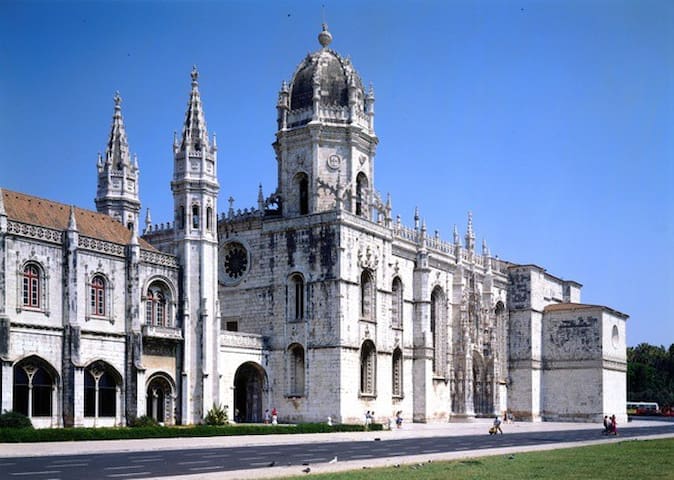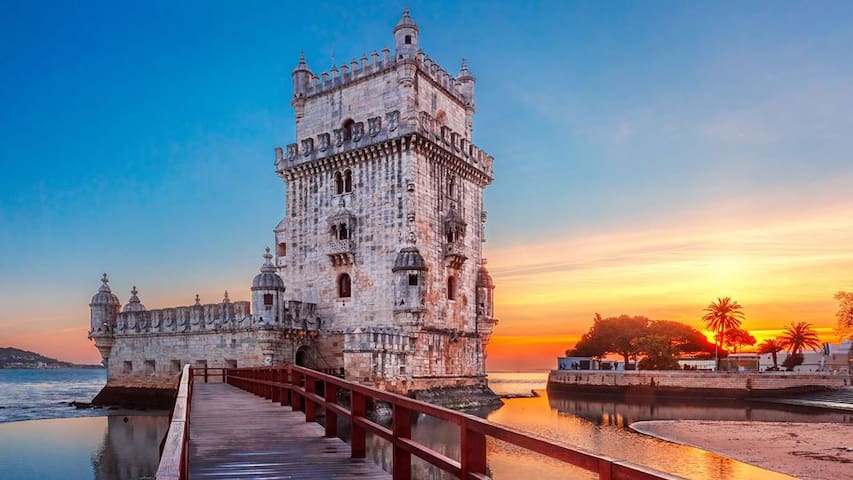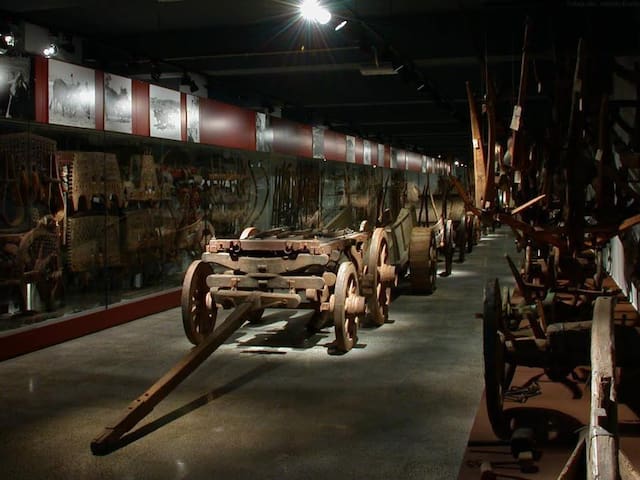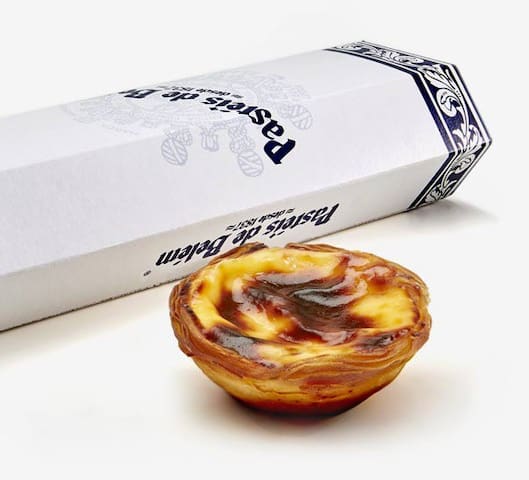Passeio turístico
In the spot where the Jerónimos Monastery stands today, next to the old Belém beach, was originally a small hermitage dedicated to Santa Maria that had been built by the Infante D. Henrique, in 1452. At the start of the 16th century King Manuel I’s intention to have a large monastery erected there was acknowledged by the Holy See, and which was donated to the Order of the Friars of St. Jerome. The epitome of Manueline architecture and intrinsically linked to the Discoveries, this monastery is the most remarkable Portuguese monastic ensemble of its time and one of the main European churches.
Construction on it began in 1501, lasted for a hundred years and was spearheaded by a remarkable group of architects and master builders both national and foreign. With an initial design by Frenchman Boytac, the work was continued by other Masters, namely João de Castilho and, in the middle of the century, Diogo de Torralva. After the arrival of the Portuguese in India, the Portuguese crown was able to fund the venture with money coming from trade with the East. King D. Manuel I channelled much of the so-called "Vintena da Pimenta" (a ‘Spice Tax’, approximately 5% of revenues from trade with Africa and the East, equivalent to 70kg of gold per year) to finance construction work.
In this monument, classified by UNESCO as a World Heritage Site, it is worth noting the facades, the church and the cloisters. On the south facade, one can admire the portal painted by João de Castilho, where the figures are arranged according to a specific hierarchy: below, Infante D. Henrique guards the entrance, the Virgin of Bethlehem blesses the monument, and Archangel Saint Gabriel, the protector of Portugal, completes the arc. The western portal, through which one enters the sacred space, is the authorship of Nicolau Chanterenne. To the left, protected by St. Jerome, is the statue of King D. Manuel, which is said to be a realistic portrait, and to the right is that of Queen D. Maria, his wife, protected by St. John the Baptist.
Inside there is the church-hall, a Manueline masterpiece by João de Castilho. Note how, in a remarkable architectural achievement, the beautiful vault of the transept is not supported by any columns. At the entrance, after the lower-choir, are the cenotaphs of the poet Luís de Camões, author of the epic poem "Os Lusíadas", and of Vasco da Gama, commander of the armada that in 1497 went to India. The kings, princes and descendants of D. Manuel I are buried in the side chapels. In the main chapel, later reconstructed by Jerónimo de Ruão, are the tombs of D. Manuel I, his son D. João III and their wives. Worthy of special mention is the solid silver tabernacle, a work of Portuguese silversmithy from the mid-17th century.
894 lokale anbefaler
Jerónimos Klosteret
In the spot where the Jerónimos Monastery stands today, next to the old Belém beach, was originally a small hermitage dedicated to Santa Maria that had been built by the Infante D. Henrique, in 1452. At the start of the 16th century King Manuel I’s intention to have a large monastery erected there was acknowledged by the Holy See, and which was donated to the Order of the Friars of St. Jerome. The epitome of Manueline architecture and intrinsically linked to the Discoveries, this monastery is the most remarkable Portuguese monastic ensemble of its time and one of the main European churches.
Construction on it began in 1501, lasted for a hundred years and was spearheaded by a remarkable group of architects and master builders both national and foreign. With an initial design by Frenchman Boytac, the work was continued by other Masters, namely João de Castilho and, in the middle of the century, Diogo de Torralva. After the arrival of the Portuguese in India, the Portuguese crown was able to fund the venture with money coming from trade with the East. King D. Manuel I channelled much of the so-called "Vintena da Pimenta" (a ‘Spice Tax’, approximately 5% of revenues from trade with Africa and the East, equivalent to 70kg of gold per year) to finance construction work.
In this monument, classified by UNESCO as a World Heritage Site, it is worth noting the facades, the church and the cloisters. On the south facade, one can admire the portal painted by João de Castilho, where the figures are arranged according to a specific hierarchy: below, Infante D. Henrique guards the entrance, the Virgin of Bethlehem blesses the monument, and Archangel Saint Gabriel, the protector of Portugal, completes the arc. The western portal, through which one enters the sacred space, is the authorship of Nicolau Chanterenne. To the left, protected by St. Jerome, is the statue of King D. Manuel, which is said to be a realistic portrait, and to the right is that of Queen D. Maria, his wife, protected by St. John the Baptist.
Inside there is the church-hall, a Manueline masterpiece by João de Castilho. Note how, in a remarkable architectural achievement, the beautiful vault of the transept is not supported by any columns. At the entrance, after the lower-choir, are the cenotaphs of the poet Luís de Camões, author of the epic poem "Os Lusíadas", and of Vasco da Gama, commander of the armada that in 1497 went to India. The kings, princes and descendants of D. Manuel I are buried in the side chapels. In the main chapel, later reconstructed by Jerónimo de Ruão, are the tombs of D. Manuel I, his son D. João III and their wives. Worthy of special mention is the solid silver tabernacle, a work of Portuguese silversmithy from the mid-17th century.
Belém Tower (Portuguese: Torre de Belém, officially the Tower of Saint Vincent (Portuguese: Torre de São Vicente) is a 16th-century fortification located in Lisbon that served as a point of embarkation and disembarkation for Portuguese explorers and as a ceremonial gateway to Lisbon. It was built during the height of the Portuguese Renaissance, and is a prominent example of the Portuguese Manueline style, but it also incorporates hints of other architectural styles. The structure was built from lioz limestone and is composed of a bastion and a 30-metre (98.4 ft), four-storey tower.
866 lokale anbefaler
Belém-tårnet
Av. BrasíliaBelém Tower (Portuguese: Torre de Belém, officially the Tower of Saint Vincent (Portuguese: Torre de São Vicente) is a 16th-century fortification located in Lisbon that served as a point of embarkation and disembarkation for Portuguese explorers and as a ceremonial gateway to Lisbon. It was built during the height of the Portuguese Renaissance, and is a prominent example of the Portuguese Manueline style, but it also incorporates hints of other architectural styles. The structure was built from lioz limestone and is composed of a bastion and a 30-metre (98.4 ft), four-storey tower.
Created by Cottinelli Telmo (1897–1948) and the sculptor Leopoldo de Almeida (1898–1975), Padrão dos Descobrimentos was first erected in 1940, in a temporary form, as part of the Portuguese World Exhibition, built with perishable materials. It had a light iron and cement frame, while the moulded sculpture had a light iron and cement frame, while the moulded sculpture was made of gypsum (formed of plaster and burlap, and reinforced by a wooden and iron structure).
The monument was reconstructed in 1960 to mark 500 years since the death of the Infante Dom Henrique (Henry the Navigator). This time it was made of concrete and rose-tinted Leiria stone masonry, with the sculptures made of Sintra limestone masonry.
The Centro Cultural das Descobertas was opened in 1985. Architect Fernando Ramalho remodelled the interior, giving the monument a viewpoint, auditorium and exhibition hall.
Standing alone in a striking position on the breakwater on the bank of the Tagus, the Monument to the Discoveries evokes the Portuguese overseas expansion, recalls the country’s glorious past and symbolises the enormity of the work carried out by the Infante, the driving force behind the Discoveries.
A stylised caravel seems to be setting out to sea, with Henry the Navigator in its prow. On the two lateral ramps ascending to the symbolic figure of the Prince are some of the significant characters of the Portuguese overseas expansion and cultural names from the age of the Discoveries, 32 in total, all portrayed with symbols that allude to their identity: navigators, cartographers, warriors, colonisers, missionaries, chroniclers and artists.
Composed of a vertical element consisting of a stylised mast oriented North-South, with two Portuguese coats of arms on each side with its five small shields, surrounded by a band with 12 castles and stylised fleurs-de-lis in the centre.
On each side are three triangular structures, each with one curved side, giving the illusion of sails blown out by the wind.
The north side is formed by two giant stones which bear inscriptions in metallic letters. On the left side, the inscription above an anchor reads ‘TO THE INFANTE DOM HENRIQUE AND THE PORTUGUESE WHO DISCOVERED THE SEA ROUTES’. On the other side, the inscription above a laurel wreath reads, ‘ON THE V CENTENARY OF THE INFANTE DOM HENRIQUE 1460–1960′.
In the middle of the monument, a flight of nine steps gives access to a platform with a view over the entire surrounding area.
The second flight of five stairs and a portal with a round arch formed by vaulted stones lead through to the interior of the monument.
The monument is flanked by two metal armillary spheres on two parallelepiped platforms.
228 lokale anbefaler
Opdagelsesmonumentet
Av. BrasíliaCreated by Cottinelli Telmo (1897–1948) and the sculptor Leopoldo de Almeida (1898–1975), Padrão dos Descobrimentos was first erected in 1940, in a temporary form, as part of the Portuguese World Exhibition, built with perishable materials. It had a light iron and cement frame, while the moulded sculpture had a light iron and cement frame, while the moulded sculpture was made of gypsum (formed of plaster and burlap, and reinforced by a wooden and iron structure).
The monument was reconstructed in 1960 to mark 500 years since the death of the Infante Dom Henrique (Henry the Navigator). This time it was made of concrete and rose-tinted Leiria stone masonry, with the sculptures made of Sintra limestone masonry.
The Centro Cultural das Descobertas was opened in 1985. Architect Fernando Ramalho remodelled the interior, giving the monument a viewpoint, auditorium and exhibition hall.
Standing alone in a striking position on the breakwater on the bank of the Tagus, the Monument to the Discoveries evokes the Portuguese overseas expansion, recalls the country’s glorious past and symbolises the enormity of the work carried out by the Infante, the driving force behind the Discoveries.
A stylised caravel seems to be setting out to sea, with Henry the Navigator in its prow. On the two lateral ramps ascending to the symbolic figure of the Prince are some of the significant characters of the Portuguese overseas expansion and cultural names from the age of the Discoveries, 32 in total, all portrayed with symbols that allude to their identity: navigators, cartographers, warriors, colonisers, missionaries, chroniclers and artists.
Composed of a vertical element consisting of a stylised mast oriented North-South, with two Portuguese coats of arms on each side with its five small shields, surrounded by a band with 12 castles and stylised fleurs-de-lis in the centre.
On each side are three triangular structures, each with one curved side, giving the illusion of sails blown out by the wind.
The north side is formed by two giant stones which bear inscriptions in metallic letters. On the left side, the inscription above an anchor reads ‘TO THE INFANTE DOM HENRIQUE AND THE PORTUGUESE WHO DISCOVERED THE SEA ROUTES’. On the other side, the inscription above a laurel wreath reads, ‘ON THE V CENTENARY OF THE INFANTE DOM HENRIQUE 1460–1960′.
In the middle of the monument, a flight of nine steps gives access to a platform with a view over the entire surrounding area.
The second flight of five stairs and a portal with a round arch formed by vaulted stones lead through to the interior of the monument.
The monument is flanked by two metal armillary spheres on two parallelepiped platforms.
The Coach Museum was an initiative of Queen D. Amélia de Orléans e Bragança, wife of King D. Carlos I (1889-1908), who inaugurated it in 1905. It contains an exceptional and unique collection of richly adorned royal vehicles, from the 17th to 19th centuries (coaches, berlins, carriages, chaises, litters, sedan-chairs), used by the Portuguese other European courts, the Patriarchs of Lisbon and Portuguese noble houses up until the advent of the motor car.
The rare example of Philip II's travelling coach (late 16th century) and the three monumental coaches that were part of the magnificent embassy sent by Portugal to Pope Clement XI in Rome (1716), with iconography in gilded woodwork glorifying the Discoveries, are some of the most notable pieces in this incomparable exhibition. The collection also includes an important store of harnesses, ceremonial and coach service liveries, a stock of 18th century armoury and accessories and the oil portraits of the monarchs of the Braganza Dynasty.
The Coach Museum (Museu dos Coches) is divided between the new building in Belém, the old Horse Riding Arena of the Royal Palace, both in Praça Afonso de Albuquerque, in Lisbon, and the Ducal Palace of Vila Viçosa.
The new National Coach Museum building, inaugurated in May 2015, houses the most representative part of the collection. Occupying a site in Belém where a former military workshop (Oficinas Gerais do Exército) once stood, it serves a two-fold purpose as a cultural facility and a public space. In the words of Pritzker prize-winning architect Paulo Mendes da Rocha, who designed it, “the museum has no doors and creates opportunities for interaction on every side.” However, the project is intended to be more than just a museum; it additionally functions as an urban infrastructure providing the city with a “public space”, responds to the museum’s need to expand its exhibition area and technical support infrastructure, and creates new aspects to be appreciated by visitors to this, Portugal’s most-visited museum. The structure comprises a main building with a suspended hall and an annex, which are connected by an overpass that allows people to move from one to the other. The layout of the buildings creates a kind of portico directed towards a freely-accessible inner square.
483 lokale anbefaler
National Coche Museum
136 Av. da ÍndiaThe Coach Museum was an initiative of Queen D. Amélia de Orléans e Bragança, wife of King D. Carlos I (1889-1908), who inaugurated it in 1905. It contains an exceptional and unique collection of richly adorned royal vehicles, from the 17th to 19th centuries (coaches, berlins, carriages, chaises, litters, sedan-chairs), used by the Portuguese other European courts, the Patriarchs of Lisbon and Portuguese noble houses up until the advent of the motor car.
The rare example of Philip II's travelling coach (late 16th century) and the three monumental coaches that were part of the magnificent embassy sent by Portugal to Pope Clement XI in Rome (1716), with iconography in gilded woodwork glorifying the Discoveries, are some of the most notable pieces in this incomparable exhibition. The collection also includes an important store of harnesses, ceremonial and coach service liveries, a stock of 18th century armoury and accessories and the oil portraits of the monarchs of the Braganza Dynasty.
The Coach Museum (Museu dos Coches) is divided between the new building in Belém, the old Horse Riding Arena of the Royal Palace, both in Praça Afonso de Albuquerque, in Lisbon, and the Ducal Palace of Vila Viçosa.
The new National Coach Museum building, inaugurated in May 2015, houses the most representative part of the collection. Occupying a site in Belém where a former military workshop (Oficinas Gerais do Exército) once stood, it serves a two-fold purpose as a cultural facility and a public space. In the words of Pritzker prize-winning architect Paulo Mendes da Rocha, who designed it, “the museum has no doors and creates opportunities for interaction on every side.” However, the project is intended to be more than just a museum; it additionally functions as an urban infrastructure providing the city with a “public space”, responds to the museum’s need to expand its exhibition area and technical support infrastructure, and creates new aspects to be appreciated by visitors to this, Portugal’s most-visited museum. The structure comprises a main building with a suspended hall and an annex, which are connected by an overpass that allows people to move from one to the other. The layout of the buildings creates a kind of portico directed towards a freely-accessible inner square.
MAAT
Avenida BrasíliaDon`t Miss This In Our Neighborhood...
Museu Nacional de Etnologia
Avenida da Ilha da MadeiraDon`t Miss This In Our Neighborhood...
Søfartsmuseet
Praça do ImpérioDon`t Miss This In Our Neighborhood...
Where to Eat
Pastel de nata is a symbol of national sweets and perhaps the best known internationally. Ours stands out from the rest for its creamy filling without being too liquid and too sweet, that is, just right. In turn, the dough is crispy and crunchy, breaking with each bite. Cold or just out of the oven, with or without cinnamon, enjoy this Portuguese delicacy.
835 lokale anbefaler
Pastéis de Belém
84 R. de BelémPastel de nata is a symbol of national sweets and perhaps the best known internationally. Ours stands out from the rest for its creamy filling without being too liquid and too sweet, that is, just right. In turn, the dough is crispy and crunchy, breaking with each bite. Cold or just out of the oven, with or without cinnamon, enjoy this Portuguese delicacy.
La Fóllia de Belém
18D R. dos JerónimosDon`t Miss This In Our Neighborhood...
A Padaria Portuguesa
44 Praça Luís de CamõesDon`t Miss This In Our Neighborhood...
Bairros
Belém, is a freguesia (civil parish) and district of Lisbon, the capital of Portugal. Belém is located in western Lisbon, to the west of Ajuda and Alcântara and directly east of Lisbon's border with Oeiras. Belém is famous as a museum district, as the home of many of the most notable monuments of Lisbon and Portugal alike, such as the Belém Tower, the Jerónimos Monastery, the Padrão dos Descobrimentos, and Belém Palace (official residence of the President of Portugal). The population in 2011 was 16,528.
217 lokale anbefaler
Belém
Belém, is a freguesia (civil parish) and district of Lisbon, the capital of Portugal. Belém is located in western Lisbon, to the west of Ajuda and Alcântara and directly east of Lisbon's border with Oeiras. Belém is famous as a museum district, as the home of many of the most notable monuments of Lisbon and Portugal alike, such as the Belém Tower, the Jerónimos Monastery, the Padrão dos Descobrimentos, and Belém Palace (official residence of the President of Portugal). The population in 2011 was 16,528.








